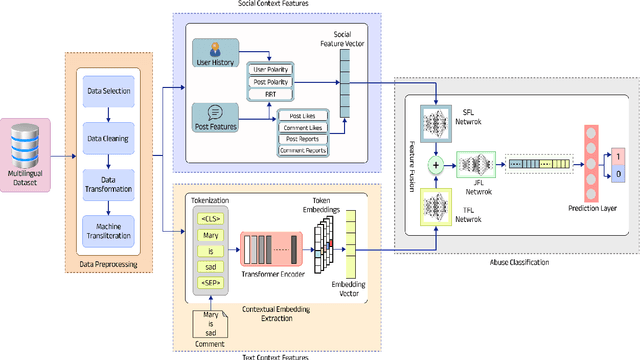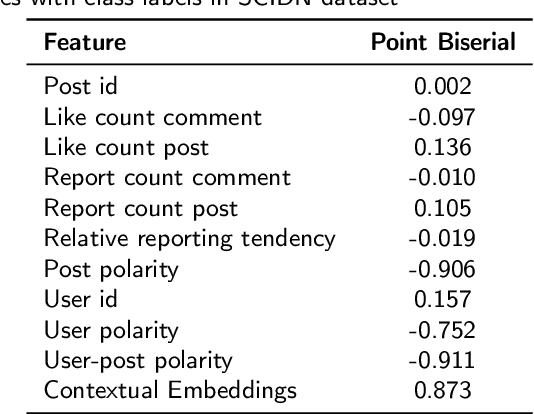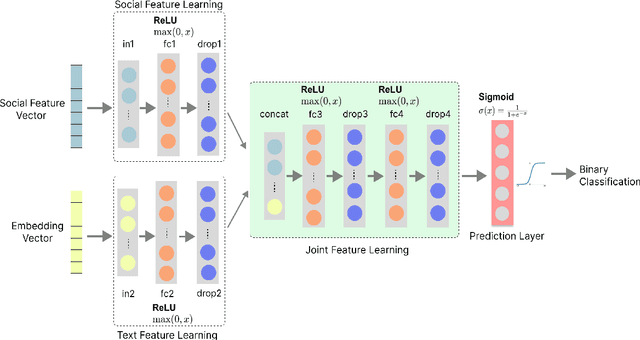Mohammad Zia Ur Rehman
User-Aware Multilingual Abusive Content Detection in Social Media
Oct 26, 2024



Abstract:Despite growing efforts to halt distasteful content on social media, multilingualism has added a new dimension to this problem. The scarcity of resources makes the challenge even greater when it comes to low-resource languages. This work focuses on providing a novel method for abusive content detection in multiple low-resource Indic languages. Our observation indicates that a post's tendency to attract abusive comments, as well as features such as user history and social context, significantly aid in the detection of abusive content. The proposed method first learns social and text context features in two separate modules. The integrated representation from these modules is learned and used for the final prediction. To evaluate the performance of our method against different classical and state-of-the-art methods, we have performed extensive experiments on SCIDN and MACI datasets consisting of 1.5M and 665K multilingual comments, respectively. Our proposed method outperforms state-of-the-art baseline methods with an average increase of 4.08% and 9.52% in F1-scores on SCIDN and MACI datasets, respectively.
An Explainable Contrastive-based Dilated Convolutional Network with Transformer for Pediatric Pneumonia Detection
Oct 21, 2024



Abstract:Pediatric pneumonia remains a significant global threat, posing a larger mortality risk than any other communicable disease. According to UNICEF, it is a leading cause of mortality in children under five and requires prompt diagnosis. Early diagnosis using chest radiographs is the prevalent standard, but limitations include low radiation levels in unprocessed images and data imbalance issues. This necessitates the development of efficient, computer-aided diagnosis techniques. To this end, we propose a novel EXplainable Contrastive-based Dilated Convolutional Network with Transformer (XCCNet) for pediatric pneumonia detection. XCCNet harnesses the spatial power of dilated convolutions and the global insights from contrastive-based transformers for effective feature refinement. A robust chest X-ray processing module tackles low-intensity radiographs, while adversarial-based data augmentation mitigates the skewed distribution of chest X-rays in the dataset. Furthermore, we actively integrate an explainability approach through feature visualization, directly aligning it with the attention region that pinpoints the presence of pneumonia or normality in radiographs. The efficacy of XCCNet is comprehensively assessed on four publicly available datasets. Extensive performance evaluation demonstrates the superiority of XCCNet compared to state-of-the-art methods.
A Hybrid Filtering for Micro-video Hashtag Recommendation using Graph-based Deep Neural Network
Oct 14, 2024Abstract:Due to the growing volume of user generated content, hashtags are employed as topic indicators to manage content efficiently on social media platforms. However, finding these vital topics is challenging in microvideos since they contain substantial information in a short duration. Existing methods that recommend hashtags for microvideos primarily focus on content and personalization while disregarding relatedness among users. Moreover, the cold start user issue prevails in hashtag recommendation systems. Considering the above, we propose a hybrid filtering based MIcro-video haSHtag recommendatiON MISHON technique to recommend hashtags for micro-videos. Besides content based filtering, we employ user-based collaborative filtering to enhance recommendations. Since hashtags reflect users topical interests, we find similar users based on historical tagging behavior to model user relatedness. We employ a graph-based deep neural network to model user to user, modality to modality, and user to modality interactions. We then use refined modality specific and user representations to recommend pertinent hashtags for microvideos. The empirical results on three real world datasets demonstrate that MISHON attains a comparative enhancement of 3.6, 2.8, and 6.5 reported in percentage concerning the F1 score, respectively. Since cold start users exist whose historical tagging information is unavailable, we also propose a content and social influence based technique to model the relatedness of cold start users with influential users. The proposed solution shows a relative improvement of 15.8 percent in the F1 score over its content only counterpart. These results show that the proposed framework mitigates the cold start user problem.
CoTCoNet: An Optimized Coupled Transformer-Convolutional Network with an Adaptive Graph Reconstruction for Leukemia Detection
Oct 11, 2024



Abstract:Swift and accurate blood smear analysis is an effective diagnostic method for leukemia and other hematological malignancies. However, manual leukocyte count and morphological evaluation using a microscope is time-consuming and prone to errors. Conventional image processing methods also exhibit limitations in differentiating cells due to the visual similarity between malignant and benign cell morphology. This limitation is further compounded by the skewed training data that hinders the extraction of reliable and pertinent features. In response to these challenges, we propose an optimized Coupled Transformer Convolutional Network (CoTCoNet) framework for the classification of leukemia, which employs a well-designed transformer integrated with a deep convolutional network to effectively capture comprehensive global features and scalable spatial patterns, enabling the identification of complex and large-scale hematological features. Further, the framework incorporates a graph-based feature reconstruction module to reveal the hidden or unobserved hard-to-see biological features of leukocyte cells and employs a Population-based Meta-Heuristic Algorithm for feature selection and optimization. To mitigate data imbalance issues, we employ a synthetic leukocyte generator. In the evaluation phase, we initially assess CoTCoNet on a dataset containing 16,982 annotated cells, and it achieves remarkable accuracy and F1-Score rates of 0.9894 and 0.9893, respectively. To broaden the generalizability of our model, we evaluate it across four publicly available diverse datasets, which include the aforementioned dataset. This evaluation demonstrates that our method outperforms current state-of-the-art approaches. We also incorporate an explainability approach in the form of feature visualization closely aligned with cell annotations to provide a deeper understanding of the framework.
A Social Context-aware Graph-based Multimodal Attentive Learning Framework for Disaster Content Classification during Emergencies
Oct 11, 2024



Abstract:In times of crisis, the prompt and precise classification of disaster-related information shared on social media platforms is crucial for effective disaster response and public safety. During such critical events, individuals use social media to communicate, sharing multimodal textual and visual content. However, due to the significant influx of unfiltered and diverse data, humanitarian organizations face challenges in leveraging this information efficiently. Existing methods for classifying disaster-related content often fail to model users' credibility, emotional context, and social interaction information, which are essential for accurate classification. To address this gap, we propose CrisisSpot, a method that utilizes a Graph-based Neural Network to capture complex relationships between textual and visual modalities, as well as Social Context Features to incorporate user-centric and content-centric information. We also introduce Inverted Dual Embedded Attention (IDEA), which captures both harmonious and contrasting patterns within the data to enhance multimodal interactions and provide richer insights. Additionally, we present TSEqD (Turkey-Syria Earthquake Dataset), a large annotated dataset for a single disaster event, containing 10,352 samples. Through extensive experiments, CrisisSpot demonstrated significant improvements, achieving an average F1-score gain of 9.45% and 5.01% compared to state-of-the-art methods on the publicly available CrisisMMD dataset and the TSEqD dataset, respectively.
A Comprehensive Survey of Mamba Architectures for Medical Image Analysis: Classification, Segmentation, Restoration and Beyond
Oct 03, 2024Abstract:Mamba, a special case of the State Space Model, is gaining popularity as an alternative to template-based deep learning approaches in medical image analysis. While transformers are powerful architectures, they have drawbacks, including quadratic computational complexity and an inability to address long-range dependencies efficiently. This limitation affects the analysis of large and complex datasets in medical imaging, where there are many spatial and temporal relationships. In contrast, Mamba offers benefits that make it well-suited for medical image analysis. It has linear time complexity, which is a significant improvement over transformers. Mamba processes longer sequences without attention mechanisms, enabling faster inference and requiring less memory. Mamba also demonstrates strong performance in merging multimodal data, improving diagnosis accuracy and patient outcomes. The organization of this paper allows readers to appreciate the capabilities of Mamba in medical imaging step by step. We begin by defining core concepts of SSMs and models, including S4, S5, and S6, followed by an exploration of Mamba architectures such as pure Mamba, U-Net variants, and hybrid models with convolutional neural networks, transformers, and Graph Neural Networks. We also cover Mamba optimizations, techniques and adaptations, scanning, datasets, applications, experimental results, and conclude with its challenges and future directions in medical imaging. This review aims to demonstrate the transformative potential of Mamba in overcoming existing barriers within medical imaging while paving the way for innovative advancements in the field. A comprehensive list of Mamba architectures applied in the medical field, reviewed in this work, is available at Github.
A Multilateral Attention-enhanced Deep Neural Network for Disease Outbreak Forecasting: A Case Study on COVID-19
Aug 26, 2024



Abstract:The worldwide impact of the recent COVID-19 pandemic has been substantial, necessitating the development of accurate forecasting models to predict the spread and course of a pandemic. Previous methods for outbreak forecasting have faced limitations by not utilizing multiple sources of input and yielding suboptimal performance due to the limited availability of data. In this study, we propose a novel approach to address the challenges of infectious disease forecasting. We introduce a Multilateral Attention-enhanced GRU model that leverages information from multiple sources, thus enabling a comprehensive analysis of factors influencing the spread of a pandemic. By incorporating attention mechanisms within a GRU framework, our model can effectively capture complex relationships and temporal dependencies in the data, leading to improved forecasting performance. Further, we have curated a well-structured multi-source dataset for the recent COVID-19 pandemic that the research community can utilize as a great resource to conduct experiments and analysis on time-series forecasting. We evaluated the proposed model on our COVID-19 dataset and reported the output in terms of RMSE and MAE. The experimental results provide evidence that our proposed model surpasses existing techniques in terms of performance. We also performed performance gain and qualitative analysis on our dataset to evaluate the impact of the attention mechanism and show that the proposed model closely follows the trajectory of the pandemic.
 Add to Chrome
Add to Chrome Add to Firefox
Add to Firefox Add to Edge
Add to Edge